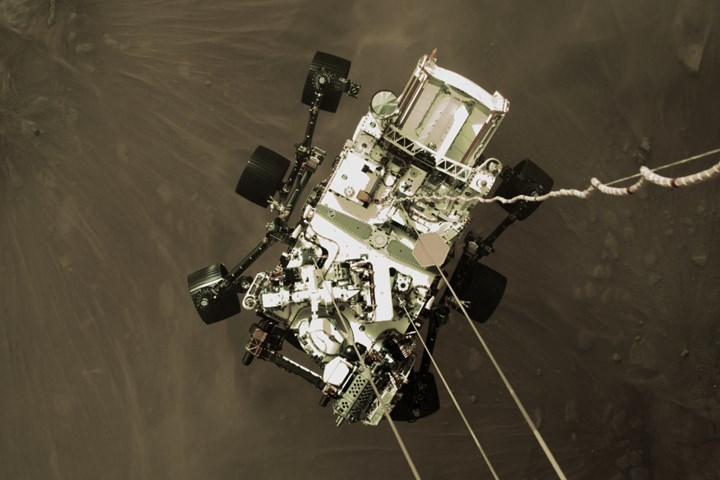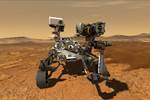Perseverance rover landing previews touchdown footage
NASA’s Perseverance rover relays a high-resolution still shot of its descent to the surface of Mars. Rover indicates positive health reports.

This high-resolution still image is part of a video taken by several cameras as NASA’s Perseverance rover touched down on Mars on Feb. 18, 2021. A camera aboard the descent stage captured this shot. Photo credit: NASA/JPL-Caltech.
Less than a week after NASA’s Mars 2020 Perseverance rover successfully landed on the surface of Mars, engineers and scientists at the agency’s Jet Propulsion Laboratory in Southern California were hard at work, awaiting the next transmissions from Perseverance. As data gradually came in, relayed by several spacecraft orbiting the Red Planet, the Perseverance team were relieved to see the rover’s health reports, which showed everything appeared to be working as expected.
Adding to the excitement was a high-resolution image taken during the rover’s landing, shown above. While NASA’s Mars Curiosity rover sent back a stop-motion movie of its descent, Perseverance’s cameras are intended to capture video of its touchdown and this new still image was taken from that footage, which is still being relayed to Earth and processed.
Unlike with past rovers, the majority of Perseverance’s cameras capture images in color. After landing, two of the Hazard Cameras (Hazcams) captured views from the front and rear of the rover, showing one of its wheels in the Martian dirt. Perseverance got a close-up from NASA’s eye in the sky, as well: NASA’s Mars Reconnaissance. Orbiter, which used a high-resolution camera to capture the spacecraft sailing into Jezero Crater, with its parachute trailing behind. The High Resolution Camera Experiment (HiRISE) camera did the same for Curiosity in 2012. JPL leads the orbiter’s mission, while the HiRISE instrument is led by the University of Arizona.
According to the team, several pyrotechnic charges also fired later after its landing on Feb. 19, releasing Perseverance’s mast (the “head” of the rover) from where it is fixed on the rover’s deck. The Navigation Cameras (Navcams), which are used for driving, share space on the mast with two science cameras: the zoomable Mastcam-Z and a laser instrument called SuperCam.
In the days to come, engineers will pore over the rover’s system data, updating its software and beginning to test its various instruments. In the following weeks, Perseverance will test its robotic arm and take its first, short drive. It will be at least one or two months until Perseverance will find a flat location to drop off Ingenuity, the mini, composites-intensive helicopter attached to the rover’s belly, and even longer before it finally hits the road, beginning its science mission and searching for its first sample of Martian rock and sediment.
Related Content
-
Infinite Composites: Type V tanks for space, hydrogen, automotive and more
After a decade of proving its linerless, weight-saving composite tanks with NASA and more than 30 aerospace companies, this CryoSphere pioneer is scaling for growth in commercial space and sustainable transportation on Earth.
-
Manufacturing the MFFD thermoplastic composite fuselage
Demonstrator’s upper, lower shells and assembly prove materials and new processes for lighter, cheaper and more sustainable high-rate future aircraft.
-
PEEK vs. PEKK vs. PAEK and continuous compression molding
Suppliers of thermoplastics and carbon fiber chime in regarding PEEK vs. PEKK, and now PAEK, as well as in-situ consolidation — the supply chain for thermoplastic tape composites continues to evolve.
















